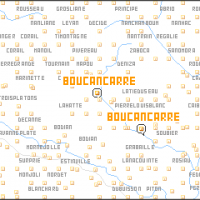Boucan Carre

Boucan-Carré, a district part of the Mirebalais Arrondissement, situates itself within the Centre Department of Haiti.
History: Boucan Carré, one of the twelve communes of the Central department, bore in the past the name of Chambo. The city was founded in 1948 and raised to the rank of commune in April 1985.
The municipality of Boucan-Carré is interior, its dominant relief is the plateau and its climate is normal. Its inhabitants are called Boucancaréen. The population of the commune of Boucan Carré was 35 917 inhabitants in 1998 and it reached 56,028 inhabitants in 2015. The area of the municipality is 137 Sq. mi. (393.55 km2) and in has a density equal to 158 inhabitants / km2.
the charcoal industry is a chief means of employment for many residents.
Geography: Boucan-Carré’s terrain is a combination of high mountain peaks and steep hollows. The Boucan-Carré River streams through the center of Chambeau, a small town, while agricultural farmlands dot the area.
Economy: At the level of the Economic and Financial Infrastructures, the commune is poor. There is no hotel, restaurants, or bank. There is only one marketing cooperative. Livestock, agriculture, and trade are the main economic activities of the municipality. Apart from a few small shops, the town has almost no commercial establishments. It has no petrol station, private morgues, pharmacies, photocopy service, etc.
Infrastructure: Many non-government organizations have come forward to help strengthen Boucan-Carré’s infrastructure. Since the early 2000’s, U.S.-based NGOs, Haiti Outreach Program, Give Haiti Hope, and Partners in Health, have supported infrastructure development and maintenance. One of its projects, a full-service medical facility, has evolved from a local community clinic.
The United Nations has performed significant road-repair work leading from Port-au-PrinceAirport into Chambeau. Upgraded roads have reduced by 50% travel time between Port-au-Prince and Chambeau, from four and a half hours to two.
While Boucan-Carré has experienced steady improvements to its infrastructure over the past decade, the 2010 earthquake delivered a knock-out punch. Thousands of earthquake survivors rushed home to extended family in Boucan-Carré. The influx of people has created a substantial burden on the city’s resources and inhabitants. Uncontaminated water is scarce, and the Haitian gourde’s decrease in value has made goods and services impossibly expensive.
Transportation: From the city to the communal sections, the roads are en terre batte. Those that connect the communal sections together are paths.
Health: The Ministry of Public Health and Population is not represented at Boucan Carré. The commune has two health centers with beds (private), a public dispensary and a private clinic. Seven doctors, five nurses, seven auxiliaries, ten matrons, three laboratory technicians and 24 other technicians train the staff of the health establishments of the commune.
Utilities: For Water, the town of Boucan Carré has four rivers, public fountains and seven springs, two of which are collected and distributed. It should also be noted that Lake Peligre passes through the third communal section of the Bayes, one of the three communal sections of the town of Boucan-Carré. The town of Boucan Carré and three of the houses (Dufally, Domond, Péligre) of the third communal section of the Bayes are electrified.
Education: The Ministry of National Education of Youth and Sports is not represented in the municipality. Mostly private primary schools, several literacy centers and one secondary school have been inventoried in the commune.
Before 2004, the town of Boucan-Carré did not have much in term of civic buildings such as schools. Thanks to the work of many outreach organizations all over the world, it now has a few schools and a church built by outreach and aid programs in Haiti.
Shopping: On Fridays, throngs of people pour into Chambeau for the town’s market day. At first, the market drew practically no vehicular traffic to its event, but since then motorcycles and all-terrain vehicles overflow it.
In the town of Boucan-Carré, fish farming is a new way in Haiti. Haiti is a country so plentiful with water but it offers so little income to fisherman. Fish Farming just like this one in Boucan-Carré is expected to boost income to the fishermen in the region.
Fish farming is one of the most viable options available for quickly restoring relative prosperity to small fish farmers in Boucan-Carré and other parts of the country. Increased fish farming will help fish farmers fight poverty in Haiti
Religion: Nearly 49 temples (chapels and stations included) have been inventoried in the commune of Boucan Carré.
Communication: The municipality at the time of the inventory had no telephone or postal office. In addition, there is no radio station, newspaper / magazine, or television station.
Leisure: The town of Boucan Carré has no library, museum, theater or cinema. The only sport practiced is football (soccer). In terms of Cultural Patromoines, the commune has a fort. Many Hougans and Mambos were also found in the commune.
Organizations: In the field of politics and other organizations, the municipality has no political parties. On the other hand, it has three grassroots organizations, six peasant groups and two women’s groups.

